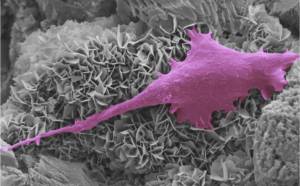This website uses cookies so that we can provide you with the best user experience possible. Cookie information is stored in your browser and performs functions such as recognising you when you return to our website and helping our team to understand which sections of the website you find most interesting and useful. More information in our Privacy Policy
Cell-Material Interaction
In vitro biological evaluations
Principal investigators: Silvia Panseri, Monica Montesi
Personnel involved: Giada Bassi, Arianna Rossi, Mohamed Saqawa, Lorenzo Apolloni, Noemi Ravaglia, Federica Arienti
The activity of the Cell-Material BioLAB is focused on the study of cell-material interaction by means of cellular and molecular biology techniques. Accuracy is the main pillar of the Lab, that is extremely important to reach the goal of the translational research to the preclinical study and to the medical use.
The laboratory of Cell-Material BioLAB aims to evaluate the biocompatibility and biofunctionality of novel biomaterials (3D scaffolds, micro- and nanoparticles, films, hydrogels, etc.) for regenerative medicine and nanomedicine.
Mammalian cell lines and primary cells (differentiated or stem cells), isolated from different tissues, are used to evaluate proliferation, adhesion, vitality, apoptosis, extracellular matrix protein synthesis activity, growth factors, inflammatory cytokines and enzymes.
Two main macro-areas of interest are: Tissue engineering and nanomedicine.
Tissue engineering
In tissue engineering studies, 3D biomaterials are analyzed in vitro looking at the cell colonization and cell differentiation together with the neo-formed tissue according to chemical and structural characteristics of scaffolds. Biomaterials are also studied also in association to biological stimulators (differentiated and dedifferentiated cells, growth factors and other signal molecules, biophysical stimulations). A perfusion bioreactor gives us the possibility to create in vitro a 3D engineered construct mimicking physiological conditions.
Nanomedicine
Nanostructured materials (e.g. novel nanoparticles) are study as innovative biomolecules delivery system (e.g. drugs, growth factors, miRNA). Real Time analysis gives us the possibility to understand how they interact with the cell membrane and follow the system inside the cells. Biophysical stimulations, like electromagnetic fields, are used for remote delivery.
Further aims of the lab are centered on excellence:
- Innovation, develop ad hoc systems/protocols for the biological study of biomaterials.
- Increase of the know-how of the cell-material interaction
- Training of young researchers in nanomedicine
- Internationality, attract foreign researchers and/or establish international collaborations
- Offer activities to the biomedical enterprises (SMEs)
Equipment and processes
- In vitro evaluation of cytotoxicity and bioactivity of new biomaterials
- 3D cell cultures with innovative biomaterials in static and dynamic conditions
- Analysis of cell viability, morphology, proliferation, gene and protein expression (Advanced fluorescence inverted microscope with TimeLapse, Real Time PCR, Western Blot)

Main collaborations
- Università di Messina (Dr.ssa A. Piperno; Dr.ssa A. Scala)
- Department of Chemistry, Maynooth University,Dublin, Ireland (Dr. D. Montagner)
- i3S – Instituto de Investigação e Inovação em Saúde, Porto, Portugal (Dr. C. Cunha)
- Institute of Molecular and Translation Medicine, Palacký University, Olomouc, Czech (Dr. V. Ranc)
Projects
- DINAMICA
- Mat2Rep
- REGROWTH
- SCREENED
- MIS-RIGENERA
- NANO4TARMED
- DRUG-MOLECULE
- PREDICTOS
- STRIKE
- DREAMi
- FINE
- MERCURY
Publications & Patents
- Rossi A, Bassi G, Cunha C, Baldisserri C, Ravaglia N, Gardini D, Molinari F, Lista F, Teran FJ, Piperno A, Montesi M, Panseri S. Magnetically Induced Anisotropic Structure in an Injectable Hydrogel for Skeletal Muscle Regeneration. J Colloid Interface Sci. 2025. 678: 334–345 doi.org/10.1016/j.jcis.2024.09.121.
- Bassi G, Rossi A, Campodoni E, Sandri M, Sarogni P, Fulle S, Voliani V, Panseri S, Montesi M. 3D tumor-engineered model replicating the osteosarcoma stem cell niche and in vivo tumor complexity. ACS Appl Mater Interfaces. 2024. DOI 10.1021/acsami.4c02567.
- Oliva R, Torcasio SM, Coulembier O, Piperno A, Mazzaglia A, Rossi A, Bassi G, Panseri S, Montesi M, Scala A. RGD-tagging of star-shaped PLA-PEG Micellar Nanoassemblies enhances Doxorubicin Efficacy against Osteosarcoma. Int J Pharm. 2024. 657: 124183. https://doi.org/10.1016/j.ijpharm.2024.124183
- Rossi A, Furlani F, Bassi G, Cunha C, Lunghi A, Molinari F, Teran FJ, Lista F, Bianchi M, Piperno A, Montesi M, Panseri S. Contactless magnetically responsive injectable hydrogel for aligned tissue regeneration. Mater Today Bio. 2024. 27, 101110. doi.org/10.1016/j.mtbio.2024.101110
- Montagner D, Moynihan E, Galiana-Cameo M, Sandri M, Ruffini A, Panseri S, Velasco-Torrijos T, Montesi M. 2D and 3D Anticancer properties of C2-functionalised glucosamine-Pt(IV) prodrugs based on cisplatin scaffold. Front Chem (section Inorganic Chemistry). 2024. 12:1388332. doi:10.3389/fchem.2024.1388332
- Luciano G, Vignolo M, Galante D, D’Arrigo C, Furlani F, Montesi M, Panseri S. Designing and Manufacturing of Biocompatible Hydroxyapatite and Sodium Trisilicate Scaffolds by Ordinary Domestic Microwave Oven. Compounds 2024, 4, 106–118. https://doi.org/10.3390/compounds4010005.
- Furlani F, Campodoni E, Sangiorgi N, Montesi M, Sanson A, Sandri M, Panseri S. Electroconductive scaffolds based on gelatin and PEDOT:PSS for cardiac regeneration. J. Biol. Macromol. 2023, 224, 266 doi.org/10.1016/j.ijbiomac.2022.10.122
- Moynihan E, Panseri S, Bassi G, Rossi A, Campodoni E, Dempsey E, Montesi M, Velasco Torrijos T, Montagner D. Development of novel Pt(IV)-Carbohydrate derivatives as targeted anticancer agents against Osteosarcoma. J. Mol. Sci. 2023, 24, 6028. https://doi.org/10.3390/ ijms24076028
- Grimaudo MA, Krishnakumar GS, Giusto E, Furlani F, Bassi G, Rossi A, Molinari F, Lista F, Montesi M, Panseri S*. Bioactive injectable hydrogels for on demand molecule/cell delivery and for tissue regeneration in the central nervous system. Acta Biomaterialia. 2022. 140: 88-101. Doi.org/10.1016/j.actbio.2021.11.038
- Furlani F, Rossi A, Grimaudo MA, Bassi G, Giusto E, Molinari F, Lista F, Montesi M, Panseri S. Controlled liposome delivery from chitosan-based thermosensitive hydrogel for regenerative medicine. Int J Mol Sci. 2022, 23, 894. https://doi.org/10.3390/ijms23020894
